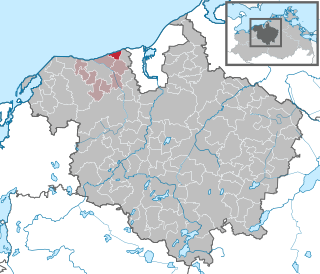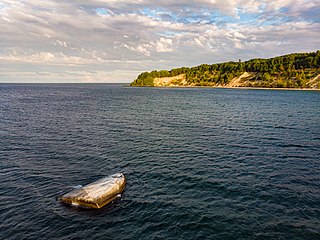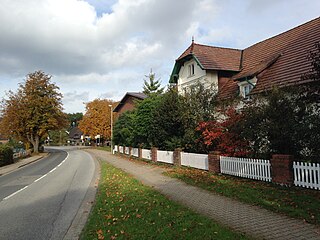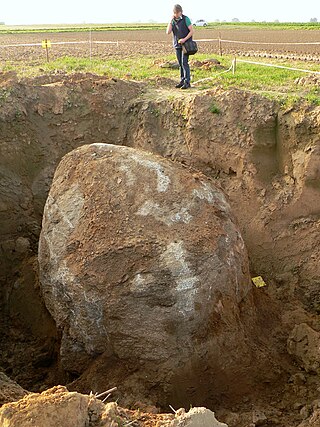
An ice age is a long period of reduction in the temperature of Earth's surface and atmosphere, resulting in the presence or expansion of continental and polar ice sheets and alpine glaciers. Earth's climate alternates between ice ages and greenhouse periods, during which there are no glaciers on the planet. Earth is in the Quaternary glaciation. Individual pulses of cold climate within an ice age are termed glacial periods, and intermittent warm periods within an ice age are called interglacials or interstadials.

A glacial erratic is glacially deposited rock differing from the type of rock native to the area in which it rests. Erratics, which take their name from the Latin word errare, are carried by glacial ice, often over distances of hundreds of kilometres. Erratics can range in size from pebbles to large boulders such as Big Rock in Alberta.

Okotoks Erratic is a 16,500-tonne (18,200-ton) boulder that lies on the otherwise flat, relatively featureless, surface of the Canadian Prairies in Alberta. It is part of the 930-kilometre-long (580 mi) Foothills Erratics Train of typically angular boulders of distinctive quartzite and pebbly quartzite.

Hagenow is a German town in the southwest of Mecklenburg-Western Pomerania, in the district of Ludwigslust-Parchim, 30 kilometers south of Schwerin. Its population is approximately 11,300 inhabitants (2013).
Franz Reinhold Schwede was a Nazi German politician, Oberbürgermeister of Coburg and both Gauleiter and Oberpräsident of Pomerania. An early supporter of Adolf Hitler in Coburg, Schwede used intimidation and propaganda to help elect the first Nazi-majority local government in Germany. This contributed to a personality cult surrounding Schwede and he became known as "Franz Schwede-Coburg." During World War II he ordered secret executions of the infirm and mass deportations of Jews. He also played a key role in abandoning the Pomeranian civilian population to the advancing Red Army, while escaping their fate himself. In 1945 he was captured by the British Army and in 1948 he was tried and convicted of war crimes.

Faßberg is a municipality in the district of Celle, in Lower Saxony, Germany. It is situated approximately 35 km north of Celle, and 30 km west of Uelzen.

Volker Lechtenbrink was a German actor on stage, in film and television, a singer-songwriter, dubbing artist, stage director and theatre manager. He played in the anti-war movie The Bridge in 1959 at age 14. He appeared in popular television series including Der Kommissar, Der Alte and Tatort. Lechtenbrink was stage director at the Ernst Deutsch Theater in Hamburg, and intendant of the Bad Hersfelder Festspiele.

Nienhagen is a municipality in the Rostock district, in Mecklenburg-Vorpommern, Germany.

Göhren is a municipality in the Vorpommern-Rügen district, in Mecklenburg-Vorpommern, Germany.

Dunsum is a municipality located on the western shore of Föhr in the district of Nordfriesland, in Schleswig-Holstein, Germany. It is composed of the districts of Greater and Lesser Dunsum.

The Deutschvölkischer Schutz- und Trutzbund was the largest and the most active anti-Semitic federation in Germany after the First World War, and an organisation that formed a significant part of the völkisch movement during the Weimar Republic (1918-1933), whose democratic parliamentary system it unilaterally rejected. Its publishing arm issued books that greatly influenced the opinions of Nazi Party leaders such as Heinrich Himmler. After the organisation folded in around 1924, many of its members eventually joined the Nazis.

The Buskam, also Buhskam or Buskamen is a large glacial erratic boulder, 325 metres off the coast of Göhren, Rügen, northern Germany. Erratics have been scattered all over northern Germany by the glaciers of the Ice Age, but are usually much smaller. The Buskam has a volume of about 600 m3, a circumference of about 40 metres, and weights about 1,600 tons. A third of it (206 m3) lies above the water surface.

The region between the Elbe and Weser rivers forms the Elbe–Weser triangle, also rendered Elbe-Weser Triangle, in northern Germany. It is also colloquially referred to as the Nasses Dreieck or "wet triangle".

This is a list of erratics on and around Rügen – the largest island off the Baltic coast of Germany. An erratic is usually defined as an individual block of rock lying on the surface of the land which has a volume of at least one cubic metre and which was transported by a glacier to its present site during the ice age.

The Nardevitz Erratic, also called the Great Rock of Nardewitz, is one of the largest glacial erratics in North Germany. It lies about 400 metres north of Nardevitz, a village in the parish of Lohme on the island of Rügen. Surrounded by trees and bushes as well as other drift material that was in the way of farming, it lies in the middle of a field. Its volume is estimated at 104 m³, which gives it a mass of 281 tonnes. The above-ground portion has a volume of 71 m³. It is therefore, apart from Buskam which lies in the Baltic Sea off Göhren, the largest erratic on Rügen and an important geological sight.

Daerstorf (help·info) is a village in the municipality Neu Wulmstorf in the district Harburg in the north of Lower Saxony, Germany. It is part of the Hamburg Metropolitan Region.

Schwiederstorf (help·info) is a village in the municipality Neu Wulmstorf in the district Harburg in the north of Lower Saxony, Germany. It is part of the Hamburg Metropolitan Region.

Die Humpty-Dumpty-Maschine der totalen Zukunft is a bronze sculpture created 2010 by Jonathan Meese, and installed at the Alte Nationalgalerie in Berlin, Germany, during 2011–2015.

The Colossus of Ostermunzel is a 27.5-tonne glacial erratic stone found in a farmer's field east of Ostermunzel in Lower Saxony, Germany, in 2013. It was excavated and moved to a new location a kilometre away.
Georg von Dadelsen was a German musicologist, who taught at the University of Hamburg and the University of Tübingen. He focused on Johann Sebastian Bach, his family and his environment, and the chronology of his works. As director of the Johann Sebastian Bach Institute in Göttingen, he influenced the Neue Bach-Ausgabe (NBA), the second complete edition of Bach's works.



















